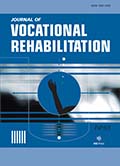Authors: Salon, Rebecca S. | Boutot, Nancy | Ozols, Keith | Keeton, Beth | Steveley, Janet
Article Type:
Research Article
Abstract:
BACKGROUND: Over the last 15 years, customization has emerged nationally as a powerful job creation strategy for a wide variety of people, including those who experience the most significant disabilities or other barriers to employment. Following the passage of the Workforce Innovation and Opportunity Act of 2014 (WIOA), the state of Oregon partnered with the National Center on Leadership for the Employment and Economic Advancement of People with Disabilities (LEAD Center) to explore a new approach to Customized Employment (CE) called Guided Group Discovery (GGD) (2018) , in which multiple systems/agencies can support youth and adults to achieve an employment
…outcome. OBJECTIVE: This paper explores approaches to bring Guided Group Discovery to scale through cross-system partnerships, leveraging Pre-Employment Transition Services (Pre-ETS) and funding to improve employment outcomes for youth. METHODS: During school year 2017-18, Oregon Vocational Rehabilitation (VR) and the LEAD Center created a partnership to modify and implement the LEAD Center’s Guided Group Discovery curriculum, with support from six school districts, to make it more accessible to youth with disabilities that were benefiting from their Pre-Employment Transition Services. This project also leveraged the resources of the workforce system, through partnerships with local American Job Centers (AJCs). RESULTS: The facilitators of GGD in the Oregon pilot sites received unanimous feedback from student participants that the GGD process had real-life impact. Students indicated that they had a better understanding of the myriad of adult service agencies available to them, as well as how to contact and connect with them. They reported that they now felt comfortable with what they have to offer an employer and knew how to communicate that to potential employers. Schools will be continuing to implement GGD, some starting with younger students, and new schools will be initiating GGD pilots in the 2018-2019 school year. CONCLUSIONS: Guided Group Discovery bridges the gap between Customized Employment and Pre-ETS services, providing an efficient process and structure for coordinating transition services. GGD is easily adapted to a school schedule and can be embedded within the framework of existing classes, clubs, afterschool programs, and summer youth employment programs. Students participating in GGD classes not only learn more about themselves, their own skills and conditions for success. They also gain confidence and become familiar with the services and supports available from adult service agencies.
Show more
Keywords: Youth employment, customized employment, discovery, competitive integrated employment, transition, pre-employment transition services
DOI: 10.3233/JVR-191013
Citation: Journal of Vocational Rehabilitation,
vol. 50, no. 3, pp. 317-323, 2019





